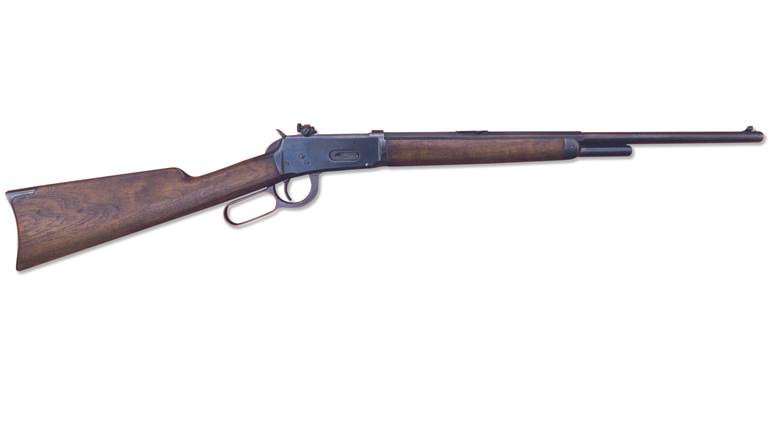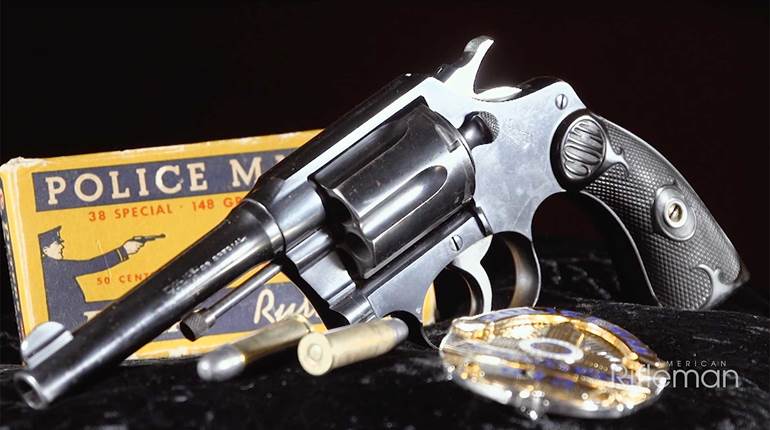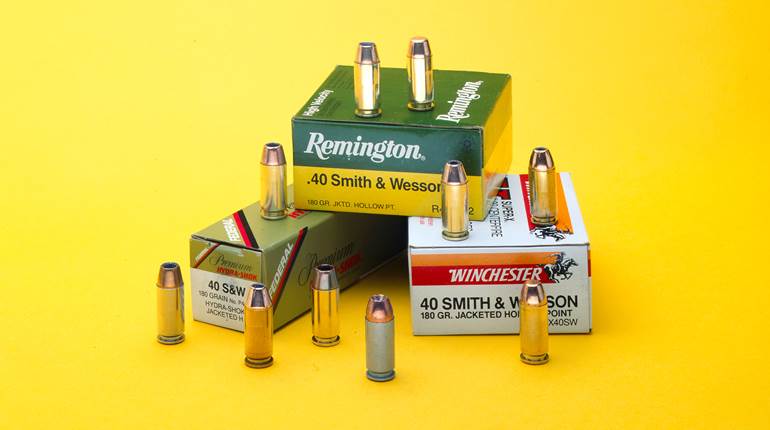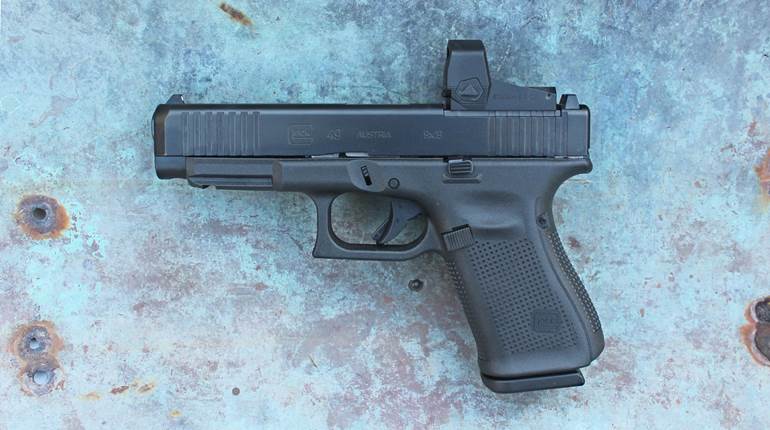
From the first recorded use of a firearm in the middle of the 13th century until 1840, guns had to be loaded from the muzzle, one shot at a time. Nearly 30 years later the first self-contained cartridge with a central primer came about, and about the same time the concept of a repeating rifle operated by an under-lever debuted. So it took roughly 450 years to go from the idea of using black powder as a fuel to launch projectiles from a tube to a breech-loading, repeating rifle. The last two decades of the 19th century were arguably some of the most fascinating due to a flurry of firearm development.
John Moses Browning took B. Tyler Henry’s concept of a lever-action rifle and began improving it. First came the Model 1886 Winchester that discarded the toggle-link lockup of the 1860,’66,’73 and ’76 lever actions and replaced it with two vertical, rectangular bolts of solid steel. The result was a rifle that was easier to operate and capable of handling some of the most powerful cartridges of the time. Then Browning miniaturized the ’86, scaling it down to handle the popular pistol cartridges of the day—the Model 1892. The development of smokeless gun powder prompted Browning to completely redesign the lever-action lock-work, producing the Model 1894 Winchester, the most successful lever-action rifle ever made.
But the development in Europe of the turn-bolt rifle and its bottlenecked, high-velocity cartridges with their pointed bullets piqued the interest of American shooters. They liked the flat-shooting, hard-hitting cartridges, however, the pointed bullets were unsuited for the tubular, under-barrel-mounted magazines of the lever actions. Americans—with their innate penchant toward the biggest, fastest and most powerful—wanted a fast-operating, lever-action rifle that could safely shoot the new bottlenecked cartridges with their pointy bullets.
Once again, Winchester turned to John Browning, and the Utah gun designer did not disappoint. Within a year of the debut of the Model 1894, Browning designed and Winchester produced the Model 1895 lever-action rifle.
The challenges facing Browning were basically twofold: First, he needed to design a magazine that could safely store and load to the breech cartridges with pointed bullets. Secondly, he needed a receiver with enough strength to handle the new high-intensity cartridges. Actually, one could say there was a third consideration, one that constantly spurred the genius gunmaker throughout his lifetime. That is, the rifle had to perform smoothly and be pleasing to the eye.
To address the first issue, Browning designed a single-column, integral box magazine that positioned the cartridges under the receiver and just behind the breech. A staggered-column magazine—a la Mauser—would increase the bulk of an already robust rifle to an unacceptable degree. The single-column magazine is utterly reliable, sleek and lightweight. Its follower is powered by a spring that extends underneath the barrel and into the fore-end. Notches toward the rear of the magazine box allow the cartridges to be freed as the round is guided up a short ramp at the breech. The bolt can then push the cartridge into the chamber.
If this system had any shortcomings, it would be the loading procedure. It is more an unfamiliar routine than a shortcoming, though. It is easier to perform than to explain. To properly load a ’95, grasp a cartridge mid-section with the thumb and forefinger; depress the follower toward the front with the head of the cartridge; slide the head of the cartridge in the hand to the rear, ensuring the head of the cartridge passes underneath the magazine lips; and tilt the front of the cartridge down to the follower or cartridge. Since most of the cartridges chambered in the ’95 had external rims, following this procedure is critical to ensuring proper feeding.
In order to harness the power of the cartridges intended for the Model 1895, Browning modified the cross-bolt locking lug he utilized in the 1894 rifle, shortening and thickening it, and mounting it in a more massive receiver. Initial Model ’95s had a round-top bolt, a flat-sided receiver that flared slightly toward the front to accommodate the fore-end and a one-piece lever. Around serial number 5000, approximately 1/16th of an inch was added to the width of the top of the receiver, along with a tapered scallop toward the bottom of the receiver to save weight. Later versions also went to a flat-topped bolt. The second model was when the one-piece lever evolved into a two-piece one.
The Model 1895 was initially offered in .30-40 Krag (often stamped .30 U.S. Army), .38-72 and .40-72. These later chamberings were never big sellers and were discontinued in 1909. The .303 British was added in 1898; 1903 saw the debut of the .35 W.C.F.; a year later, the great .405 Winchester became part of the Model 1895 line. In 1905, the .30-03 was added, only to be supplanted by the .30-06 in 1908. A contract with Russia that scooped up nearly half of the total production of Model 1895 Winchesters were chambered in 7.65x54R.
Rifle versions had barrels from 24 to 30 inches in length, depending on chambering and the customer’s order. Carbines had a standard barrel length of 22 inches, musket barrels stretched to 28 inches. Stocks were usually of straight-grained wood. Crescent buttplates were standard on rifles, while carbines and muskets had a modified shotgun-style buttplate. True shotgun-style buttplates of steel or hard rubber were available on special order. Pistol-grip stocks were seen on some early ’95s with flat receivers, but when the second models came about with heavier, fluted receivers and two-piece levers, the pistol-gripped stock was no longer an option. Three specific second-model rifles were specially adapted to pistol grips.
The Model 1895 was a popular rifle among hunters. Most famous, of course, is President Theodore Roosevelt and his son, Kermit, who took three Model ’95s —two in .405 Winchester and one in .30-03 to Africa in 1909. Martin and Osa Johnson were also known to favor Model ’95s, as did the author Stewart Edward Wright. The U.S. Army contracted for 10,000 copies in May 1898, but delivery was fraught with problems. A year later, 100 Model ’95 muskets were sent to the Philippine Islands, but the local Ordnance Board’s unfavorable report resulted in the sale of those muskets to a Boston dealer. The remaining 9,900 muskets were shipped to a New York dealer who sold them to Cuba in 1906. Some 293,816 Model ’95 muskets were sold under contract to Russia from 1915 to 1916. A few other smaller nations procured nominal amounts of the Model 1895 muskets, and Mexican revolutionaries—particularly Pancho Villa and his henchmen—were fond of it as well.
Some of the rarest versions of the Model 1895 are the NRA muskets. Beginning in 1904 with the .30 Army (.30-40 Krag), these special-ordered muskets featured 24- to 30-inch barrels, Model 1901 Krag-Jorgenson sights and flat buttplates. From 1908 to 1917, NRA muskets were available in .30-03, and the .30-06 was chambered in it from 1907 through 1926.
This last lever-action rifle designed by John Browning had a pretty good run, from 1895 through 1936—though a few more were assembled from parts as late as 1940. In all about 425,000 Model 1895 rifles were produced, more than three quarters of them muskets. Forty-eight years after production in New Haven officially ceased, Browning introduced a limited-edition Model 1895, manufactured by Miroku in Japan. Calibers were .30-06 and .270 Winchester. Eleven years later, in 1995, USRAC offered a limited edition Model 1895 in .405 Winchester; then offered it again in 2005 in a takedown version, of which I have one.
In the end, what precipitated the demise of the ’95 was the cost to produce it. This rifle requires a lot of costly machining and hand fitting. Hunters and shooters could get the same performance and cartridges from less expensive surplus bolt-action rifles. The Depression was the final nail in the coffin for this elegant and graceful rifle.





































